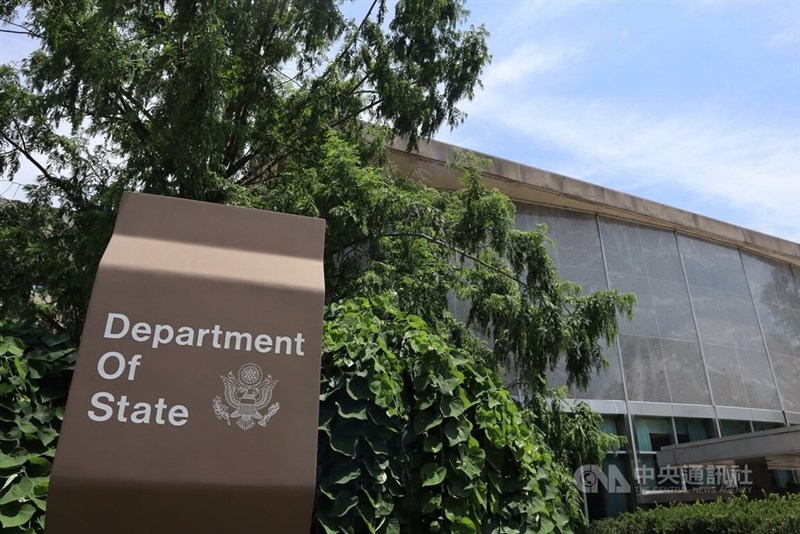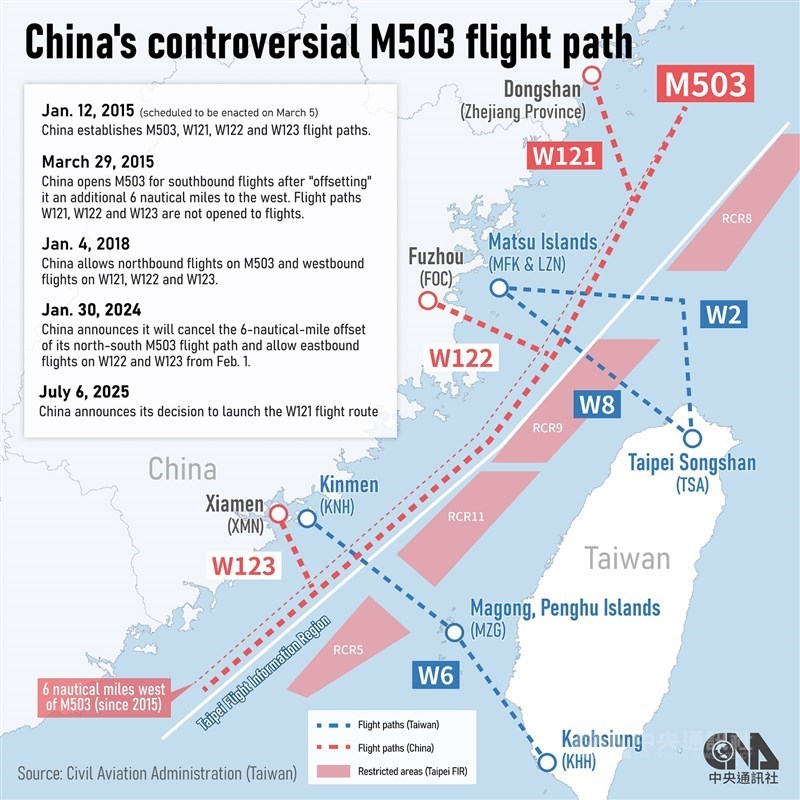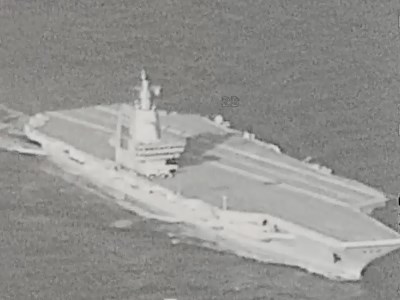DEFENSE/U.S. urges dialogue to resolve Taiwan-China flight route disputes

Washington, July 8 (CNA) The U.S. State Department has urged China and Taiwan to enter into dialogue to resolve flight route disputes across the Taiwan Strait after Beijing announced its unilateral decision to launch the W121 flight route over the weekend.
In a reply to CNA's inquiry, a U.S. State Department spokesperson said Sunday that the United States expected cross Taiwan Strait differences to be resolved "by peaceful means, free from coercion, in a manner acceptable to the people on both sides of the Strait."
The spokesperson said that the U.S. stance related to cross-strait disputes was consistent.
"Issues related to civil aviation and safety in the Taiwan Strait should be decided through dialogue between both sides," the spokesperson said.
The statement from the U.S. State Department was a response to China's unilateral announcement earlier Sunday that it would open the northwest-to-southeast W121 route connecting Dongshan in Zhejiang province to the north-south M503 flight route.

It was not the first time Beijing has acted unilaterally on establishing flight routes.
China moved the M503 route eastwards and closer to the median line of the Taiwan Strait in February 2024, despite protests from Taiwan.
The M503 route, unilaterally declared by China in 2015, is located in the Shanghai Flight Information Region but very close to the Taipei Flight Information Region, raising concerns about flight safety and Taiwan's sovereignty.
After negotiations with Taiwan, when it was still governed by a Kuomintang (KMT) administration that favored better cross-Strait relations, China agreed to move the M503 route six nautical miles to the west of its original path.
But Beijing announced on Jan. 30, 2024 that it was shifting the route eastward again, effective Feb. 1.
The opening of the W121 flight route comes after W122 and W123, two other west-to-east flight paths to the south of W121, were opened last year at the same time as the M503 route was moved eastward.
Michael Mazza, Senior Director for Research of the Institute for Indo-Pacific Security, told CNA on Monday that the unilateral openings of the flight routes represented both symbolic and substantive actions from China.
In a symbolic way, Mazza said China wanted to use the launches to demonstrate sovereignty over the skies, hoping to make Taiwan feel isolated, as the International Civil Aviation Organization (ICAO) will not object.
Substantively, Mazza said, these routes posed a national security concern to Taiwan as they allow Chinese pilots who might be involved in future military action against Taiwan to familiarize themselves with routes over the Taiwan Strait.
He said China may use these routes to approach Taiwanese airspace without raising alarms by disguising military aircraft as civilian carriers.
"Overall, China's air route machinations are part and parcel of a broader effort to pressure, envelop, and complicate the defense of Taiwan," Mazza said.
![A first: Taiwan spots new PLA aircraft carrier sailing in Taiwan Strait]() A first: Taiwan spots new PLA aircraft carrier sailing in Taiwan StraitTaiwan's military has spotted China's new aircraft carrier, the Fujian, for the first time since it was commissioned making a transit through the Taiwan Strait and released a surveillance photograph of it.12/17/2025 11:30 AM
A first: Taiwan spots new PLA aircraft carrier sailing in Taiwan StraitTaiwan's military has spotted China's new aircraft carrier, the Fujian, for the first time since it was commissioned making a transit through the Taiwan Strait and released a surveillance photograph of it.12/17/2025 11:30 AM![U.S. House passes defense bill backing joint drone program with Taiwan]() U.S. House passes defense bill backing joint drone program with TaiwanThe U.S. House of Representatives on Wednesday passed the compromise National Defense Authorization Act (NDAA), which includes authorization of up to US$1 billion for Taiwan-related security cooperation and a joint drone program.12/11/2025 01:32 PM
U.S. House passes defense bill backing joint drone program with TaiwanThe U.S. House of Representatives on Wednesday passed the compromise National Defense Authorization Act (NDAA), which includes authorization of up to US$1 billion for Taiwan-related security cooperation and a joint drone program.12/11/2025 01:32 PM![Local opposition to Taiwan's defense budget may confuse international community: U.S. envoy]() Local opposition to Taiwan's defense budget may confuse international community: U.S. envoyThe United States representative to Taiwan Raymond Greene said Wednesday that the international community might find it hard to understand the domestic criticisms of Taiwan's efforts to increase its defense budget.12/11/2025 12:11 PM
Local opposition to Taiwan's defense budget may confuse international community: U.S. envoyThe United States representative to Taiwan Raymond Greene said Wednesday that the international community might find it hard to understand the domestic criticisms of Taiwan's efforts to increase its defense budget.12/11/2025 12:11 PM
- Politics
KMT's Tainan mayoral nominee waves 'prop handgun' during rally
12/25/2025 08:23 PM - Cross-Strait
Taiwan patrol vessels monitor Chinese coast guard in Kinmen waters
12/25/2025 07:57 PM - Society
Taoyuan airport's Terminal 3 north concourse to ease peak-hour congestion
12/25/2025 06:50 PM - Society
Taipei Zoo celebrates Christmas with gifts for animal residents
12/25/2025 05:06 PM - Politics
Echoing Trump, KMT, TPP propose 'Taiwan Future Accounts' for children
12/25/2025 04:48 PM


